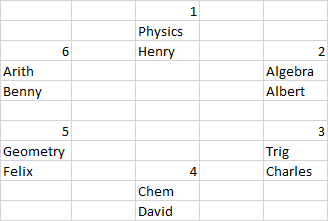The puzzle is as follows:
In a teacher's lounge there is a circular table where the teachers eat their meals during lunch time. The teachers' names are Albert, Benny, Charles, David, Henry and Felix, and they are teachers of algebra, arithmetics, geometry, trigonometry, physics and chemistry. The seats are positioned symmetrically around the table.
The physics teacher, who had differences with Albert, sat in front of David.
The algebra teacher sat between the trigonometry and physics teachers.
Henry sat next to, and to the right of, the algebra teacher.
Charles is sitting to the right of the chemistry teacher.
The algebra teacher sat in front from Felix and to the left of the physics teacher.
Professor Benny loves numerical calculations, and he is in front of the professor of trigonometry.
Given these clues, who is the geometry teacher?
The choices given in my book are as follows:
- Felix
- Albert
- Charles
- Henry
I found this puzzle in my book Reason and Logic from 2000s. It belongs to the topic of Ordering information. From the style it seems adapted from a reprinted copy of Martin Gardner's 70's book on Puzzle Carnival.
This sketch shows what I have tried so far:
However I'm stuck with because I don't know what sat in front of means. I think that they are equally distributed, so seats are arranged around the table like an hexagon (hence the hexagon in a lighter shade). This would mean that the phrase sat in front of could mean the directions indicated by the arrows. However, I'm not sure if this is the correct interpretation. I'm stuck with the Algebra teacher, because it seems he's used as a pivot to arrange the rest surrounding him. There seems to be a contradiction when I reach the part which mentions the chemistry teacher, which causes me to put David in another place.
I think that the occupations of each teacher around the table is not the same order as the given list, and that using the clues I must find which belongs to each person. But this part is confusing.
I'm not good with ordering or spotting places in a distribution relying on imagination. Therefore, all answers must include a drawing and a step by step approach explaining the meaning of each clue and how should be interpreted. I'm really lost on this one. Also, are my initial findings in the right track?



